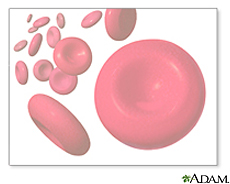 |
 |
 |
Other Health Topics:

-
Related Topics
-
Go Local
- Services and providers for Hemochromatosis in the U.S.
-
National Institutes of Health
- The primary NIH organization for research on Hemochromatosis is the National Heart, Lung, and Blood Institute
Hemochromatosis is an inherited disease in which too much iron builds up in your body. It is one of the most common genetic diseases in the United States.
Iron is a mineral found in many foods. Your body normally absorbs about 10 percent of the iron in the food you eat. If you have hemochromatosis, you absorb more iron than you need. Your body has no natural way to get rid of the extra iron. It stores it in body tissues, especially the liver, heart and pancreas. The extra iron can damage your organs. Without treatment, it can cause your organs to fail.
The most common treatment is to remove some blood, just like when you donate blood. This is called therapeutic phlebotomy. Medicines may also help remove the extra iron. Your doctor might suggest some changes in your diet.
National Heart, Lung, and Blood Institute
-
Genetics Home Reference: Hemochromatosis
 (National Library of Medicine)
(National Library of Medicine)
-
Hemochromatosis
 (National Heart, Lung, and Blood Institute)
(National Heart, Lung, and Blood Institute)
-
Hereditary Hemochromatosis(American Academy of Family Physicians)
Also available in Spanish
| Basics | Learn More | Multimedia & Cool Tools |
|---|---|---|
| Research | Reference Shelf | For You |
-
Overviews
-
Hemochromatosis
 (National Institute of Diabetes and Digestive and Kidney Diseases)
(National Institute of Diabetes and Digestive and Kidney Diseases)
- Hemochromatosis(Mayo Foundation for Medical Education and Research)
- Iron Overload and Hemochromatosis(Centers for Disease Control and Prevention)
-
Learning about Hereditary Hemochromatosis
 (National Human Genome Research Institute)
(National Human Genome Research Institute)
-
Hemochromatosis
-
Diagnosis/Symptoms
- Ferritin Test(American Association for Clinical Chemistry)
- Serum Iron Test(American Association for Clinical Chemistry)
- TIBC (Total Iron-Binding Capacity) & Transferrin Test(American Association for Clinical Chemistry)
-
Specific Conditions
- Acquired Iron Overload(Iron Disorders Institute)
- African Iron Overload (Siderosis)(Iron Disorders Institute)
-
Related Issues
- About Iron(Iron Disorders Institute)
-
Tutorials
- What Is Hemochromatosis?(Dolan DNA Learning Center)
-
Clinical Trials
-
ClinicalTrials.gov: Hemochromatosis
 (National Institutes of Health)
(National Institutes of Health)
-
ClinicalTrials.gov: Hemochromatosis
-
Genetics
-
Genetics Home Reference: Hemochromatosis
 (National Library of Medicine)
(National Library of Medicine)
-
Learning about Hereditary Hemochromatosis
 (National Human Genome Research Institute)
(National Human Genome Research Institute)
-
Genetics Home Reference: Hemochromatosis
-
Journal Articles
References and abstracts from MEDLINE/PubMed (National Library of Medicine)
- Article: Knockdown of beta2-microglobulin perturbs the subcellular distribution of HFE and...
- Article: The natural history of serum iron indices for HFE C282Y...
- Article: Gene symbol: HAMP. Disease: Haemochromatosis, juvenile.
- Hemochromatosis -- see more articles
-
Organizations
-
National Heart, Lung, and Blood Institute

-
National Institute of Diabetes and Digestive and Kidney Diseases

-
National Heart, Lung, and Blood Institute
-
Children
- Hereditary Hemochromatosis(Nemours Foundation)
| Home | Health Topics | Drugs & Supplements | Encyclopedia | Dictionary | News | Directories | Other Resources | |
| Disclaimers | Copyright | Privacy | Accessibility | Quality Guidelines U.S. National Library of Medicine, 8600 Rockville Pike, Bethesda, MD 20894 National Institutes of Health | Department of Health & Human Services |
Date last updated: 21 January 2009 Topic last reviewed: 19 December 2008 |






